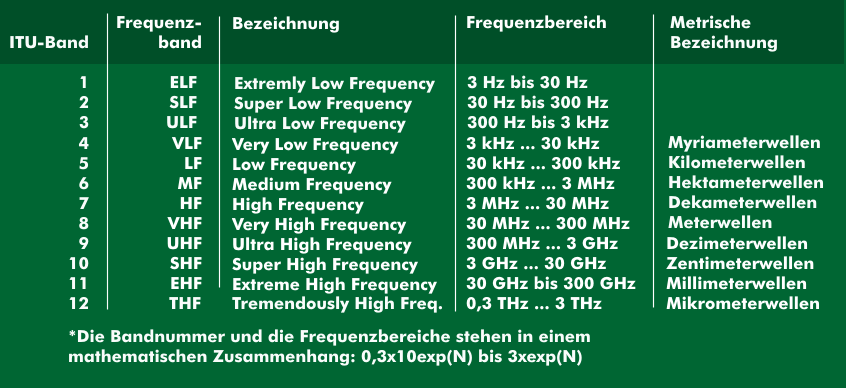frequency domain
The subdivision of the entire frequency spectrum into individual ranges reserved for specific applications or techniques is called frequency domain. The entire frequency spectrum consists of sound waves, electromagnetic waves and light waves.
A rough division of the complete frequency domain identifies the range above sound waves between 30 kHz and 300 MHz as high frequency, the frequency range between 300 MHz and 300 GHz as microwaves, and the range above that between 300 GHz and 400 THz as infrared, followed by visible light.
The audio, radio frequency and microwave ranges are each divided decadally into individual frequency ranges, specifically named and identified by an acronym. A well-known example from broadcasting technology is long wave, Low Frequency( LF), in the frequency range from 30 kHz to 300 kHz.
Within the defined frequency ranges, narrower frequency ranges used for specific applications are called frequency bands.
The frequency bands were defined according to various criteria that have a historical significance, but they are now obsolete. For Europe, the frequency bands were redefined and consecutively assigned letters, starting with the A band with a frequency range from 100 MHz to 250 MHz, followed by the B band, and so on. The frequency band with the highest frequency is the M-band between 60 GHz and 100 GHz. Due to the new designation, there are different frequency bands with identical designations but completely different frequency ranges. For example, the L band in the old nomenclature is in the 1 GHz range, while in the new version it is between 40 GHz and 60 GHz. Irritations can therefore not be ruled out.
If a specific frequency spectrum is allocated to an application, this is also referred to as a frequency range. For example, the C network for mobile communications is in the frequency range from 451.30 MHz to 465.74 MHz, and the Digital Cellular System( DCS) is in the frequency range from 1.71 GHz to 1.88 GHz, DCS 1800.


-und-der-europaeischen-Version.png)